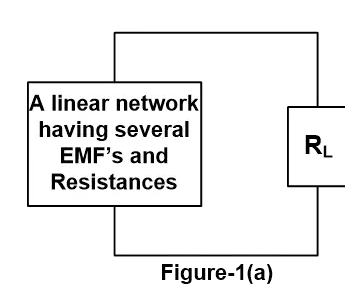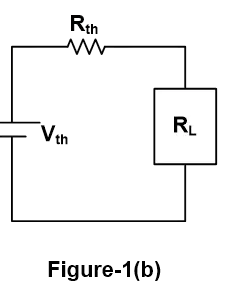Thevenin Equivalent Voltage And Resistance: What is it?
What is Thevenin’s Theorem (Thevenin Equivalent)?
Thevenin theorem (also known as the Helmholtz–Thévenin theorem) states that any linear circuit containing only voltage sources, current sources, and resistances can be replaced by an equivalent combination of a voltage source (VTh) in series with a single resistance (RTh) connected across the load. This simplified circuit is known as the Thevenin Equivalent Circuit.
Thevenin’s theorem was invented by a French engineer Léon Charles Thévenin (hence the name).
Thevenin theorem is used to convert a complex electrical circuit to a simple two-terminal Thevenin equivalent circuit. A Thevenin equivalent circuit contains one Thevenin resistance and Thevenin voltage source connected with a load, as shown in the figure below.


Thevenin resistance (Rth) is also known as equivalent resistance. And Thevenin voltage (Vth) is an open-circuit voltage across load terminals.
This theorem is suited with only linear circuits. If the circuit has elements like semiconductor components or gas-discharging components, you can not apply Thevenin’s Theorem
Thevenin Equivalent Formula
Thevenin equivalent circuit contains an equivalent voltage source, equivalent resistance, and load as shown in above figure-1(b).
Thevenin equivalent circuit has a single loop. If we apply a KVL (Kirchhoff’s Voltage Law) to this loop, we can find the current passing through the load.
According to the KVL,
How to Find The Thevenin Equivalent Circuit
The Thevenin equivalent circuit contains Thevenin resistance and Thevenin voltage source. therefore, we have to find these two values for Thevenin equivalent circuit.
Thevenin Equivalent Resistance
To calculate the Thevenin equivalent resistance, remove all power sources from the original circuit. And voltage sources are short-circuited and current sources are opened.
Hence, the remaining circuit has only resistances. Now, calculate the total resistance between the open connection points across load terminals.
The equivalent resistance is calculated by making series and parallel connection of resistances. And find a value of equivalent resistance. This resistance is also known as Thevenin resistance (Rth).
Thevenin Equivalent Voltage
To calculate the Thevenin equivalent voltage, the load impedance is open-circuited. And find an open-circuit voltage across the load terminals.
Thevenin equivalent voltage (Veq) is equal to the open-circuit voltage measured across two terminals of load. This value of the ideal voltage source is used in Thevenin equivalent circuit.
Thevenin Equivalent Dependent Source
If a circuit network consists of some dependent sources, the Thevenin resistance is calculated by a different method. In this condition, the dependent sources kept as it is. You cannot remove (open or short circuit) the voltage or current sources.
There are two methods to find Thevenin resistance in the case of dependent sources.
Method 1
In this method, we have to find Thevenin voltage (Vth) and short-circuit current (Isc). Put these values in the below equation to find the Thevenin resistance.
Thevenin voltage is same as the voltage across the terminals A and B. And we have the value of Thevenin voltage. Short-circuit current is obtained by shorting load terminals and find a current that passes through the shorted branch.
While calculating the short-circuit current, voltage and current sources remains as it is. Do not open or short circuit sources, whether it is depended or independent source.
Method 2
In this method, an extra known value of voltage source (V1) is connected across the load terminals. And find the current (I1) passing through the voltage source by keeping all dependent and independent sources.
After getting these values, put them in the below equation to find the Thevenin resistance.
Thevenin and Norton Equivalent Circuits
Thevenin’s and Norton’s theorems are used in circuit analysis to convert a complex network into a simple network. In Thevenin’s theorem, a complex circuit converts into a Thevenin equivalent circuit. Similarly, in Norton’s theorem, a complex circuit converts into Norton’s equivalent circuit.
Norton’s equivalent circuit consists of a Norton equivalent resistance and Norton current source connected in parallel with the load. Norton’s equivalent circuit is as shown below figure.
The method to calculate, Norton equivalent resistance is the same as the Thevenin equivalent resistance.
Thevenin equivalent circuit consists of a single voltage source (Thevenin voltage) and Norton equivalent circuit consists of a current source (Norton current).
Consider a network converted into Thevenin and Norton equivalent circuit. In both circuits, if you find the current and voltage across the load, it will be the same values as the original circuit is same.
If we want to find the relation between Thevenin and Norton equivalent circuits, we need to find the relation between Thevenin voltage and Norton current.
This relation can be found by ohm’s law;
Limitation of Thevenin Theorem
In circuit analysis, Thevenin’s theorem is used widely to solve complex circuits.
Still, there are some limitations in Thevenin’s theorem which are listed below.
This theorem does not apply to unilateral networks. Unilateral networks mean that the operation and behaver of a network are dependent on the direction of current through various components of networks.
Thevenin’s theorem applies only to networks that consist of linear elements. It cannot apply to nonlinear elements.
There should not any magnetic coupling between the circuit and load.
There should not any controlled sources, controlled from some other circuit part of the circuit.
Source: Electrical4u.
Statement: Respect the original, good articles worth sharing, if there is infringement please contact delete.
Electrical4U is dedicated to the teaching and sharing of all things related to electrical and electronics engineering.













